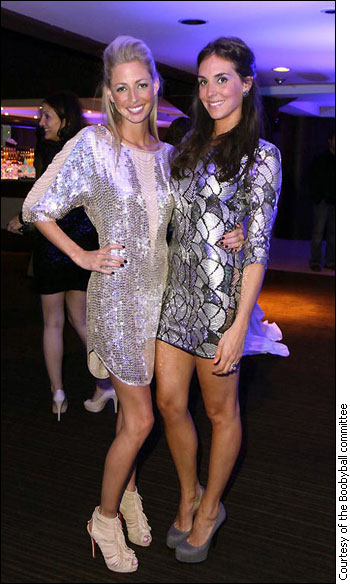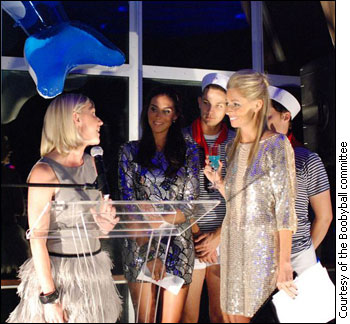Tags
Related Posts
Share This
Save the boobs: breast cancer awareness, made cool
Picture a beautiful young woman in a bikini, walking confidently into a pool scene, surrounded by gawking men and women, all staring at her breasts. It may sound like a beer commercial: but not this time. Instead of trying to sell a product, a recent viral video was selling a message — to save the boobs.
The video features Aliya-Jasmine Sovani, host and segment producer of MTV News Canada, with the camera tight on her bouncing breasts. The message appears onscreen: “You know you like them…now it’s time to save the boobs.” The video ends with a statistic, that breast cancer is the leading cause of cancer death in young women, ages 20 to 49.

Attention getting: Aliya-Jasmine Sovani in the hit cancer-awareness viral video Save the Boobs.
Sovani says people like breasts and are used to seeing them in advertising, but there’s a huge disconnect between those breasts and the breasts affected by cancer.
“This video was really just supposed to shock you into realizing that the breasts in breast cancer are the same ones that you appreciate or you look at or you have,” she says.
The Save the Boobs video was a viral hit, spreading quickly across the Internet. Sovani, who came up with the idea and wrote it, says she wanted it to be fun and sexy, something that people would open on their computers and watch. And people certainly did.
The video was viewed online hundreds of thousands of times and was picked up by the news media. In the end, it reached many people who weren’t on the Internet.
“This thing was all over the place,” says Tom Megginson, a creative director at Acart Communications in Ottawa. According to Megginson, viral marketing is about being bold and breaking boundaries, which this video achieved in order to reach young viewers.
The video was a promotional tool to sell tickets to a Toronto breast cancer fundraiser called the Boobyball, which Sovani co-chaired this year. It was sensationally effective, helping to sell out all 1,100 tickets.
The video is an example of the creative tools now being used to direct young people’s attention to the breast cancer cause. The idea is to raise young women’s awareness that breast cancer can affect them, too, says Sovani.
Appealing to a younger crowd
People today in the breast cancer awareness field are trying to appeal to younger audiences through three strategies: viral marketing (whereby a marketing message passes from user to user via Internet and social media), charity events aimed at people in their 20s and 30s and other programs aimed at young women affected by or concerned about breast cancer.
It’s important that young women be aware of breast-health messages, because while most women who get breast cancer are older, 23 per cent of all cases are women under 50.
It is the most common cancer to affect women, says Marisa Weiss, a breast oncologist and breast-health author.
Therefore it’s important that women do all they can to reduce their risk of getting it, says Weiss. If they do get it, it’s important they find out this fact as early as possible, she adds.
Twenty-three per cent of all breast cancer cases are women under 50.
“Young women have the greatest opportunity to prevent breast cancer if they start breast-health practices at a young age,” says Weiss. “So there’s a great opportunity to reduce the devastation of this disease.”
Weiss says this means young women should not smoke and should stick to a healthy weight, limit their alcohol intake, exercise three to four hours a week and avoid hormones in their food.
Also, young women can self-examine their breasts on a regular basis, looking for lumps or other abnormalities, and notify their doctors of any changes, says Weiss. By starting this at a younger age, women will develop a better sense of what’s normal and what’s not.
Partying with a purpose
It’s important that such breast-health messages get through to young women. Hence the need for events like the Boobyball, which get younger people involved and raise consciousness among younger women.
Thanks partly to the attention-grabbing Save the Boobs video, 2009’s Boobyball was a huge success. The sold-out, cruise-themed event raised $160,000 from ticket sales, an online auction, on-site fundraising, event sponsorship and private donations.

Hosts Ashleigh Dempster and Amanda Blakley at the 2009 Boobyball.
The Boobyball was started in 2002 by a group of young men and women in Toronto, to help raise the spirits of their friend Sarah O’Regan, who was diagnosed with breast cancer at age 23.
Amanda Blakley and Ashleigh Dempster were part of that founding group. In 2006, Blakley and Dempster co-founded a culture club called The Society, which has presented the Boobyball since then.
Dempster says the Boobyball is anything but a stodgy fundraiser.
“It’s wild and fun, and it’s crazy, and there’s no sit-down dinner,” she says. It’s attractive to young people, adds Blakley.
Sovani agrees. “[The Boobyball] is getting a bunch of young people involved by doing what young people do anyways – which is party,” says Sovani. “So it was like partying for breast cancer, and raising money in that way.”
The event raises money for Rethink Breast Cancer, a Toronto-based organization that tries to reach younger women in creative ways, promoting breast-health awareness with a variety of educational and support programs. The organization hosts edgy events and designs materials aimed at a younger demographic.
One of Rethink Breast Cancer’s jobs is to administer a program called the Booby Innovation Grant, to fund new projects spearheaded by breast cancer survivors. The program gives survivors an opportunity to submit proposals for innovative tools they think will help improve life quality for other newly diagnosed women going through treatment. The grant will then fund one or more of these projects.
This B.I.G. is the program to which 60 per cent of the Boobyball’s net funds will go. The rest will go towards Rethink Breast Cancer’s existing programs, research and support services.
M.J. DeCoteau, executive director of Rethink Breast Cancer, helped found it in 2001 upon realizing that breast cancer information wasn’t reaching young women. After her mom died from breast cancer, DeCoteau, then 22, began researching her own risk, but says the information she found wasn’t much designed to motivate someone her age.
DeCoteau says there is a lot of information out there, but it isn’t very inviting to young women because it’s either too medical or intimidating, or it simply has an older face on the brochure, which naturally suggests that cancer is something women don’t have to think about until they are older.
She says Rethink Breast Cancer was an easy concept to sell.
The idea has hit a nerve in Canada. DeCoteau says people have really responded, whether to being shown that breast cancer materials don’t have to be designed for a 65-year-old, or to being invited to events that are fun and upbeat, have cool music and otherwise appeal to young people.
Rethink Breast Cancer’s events have become popular, drawing in hundreds of young women and men. The annual Rethink Breast Cancer Romp in Toronto attracts over 600 people.

Breast cancer survivor Sarah O’Regan, left, speaks at the Boobyball, which was founded in her honour.
DeCoteau says it’s important to reach younger women because, although they belong to a smaller cancer demographic, they too can have lives shaken by the disease. Many young women are just starting careers or have small children, she says. A breast cancer diagnosis can easily bring severe consequences to the family.
Side effects of treatment can include fertility issues or early menopause, she says. And with young women, these changes would happen at an early life stage.
While other breast cancer organizations agree, they don’t focus exclusively on young women. For example, the Canadian Breast Cancer Foundation tries to reach everyone, as breast cancer can strike people of any age, says Naomi Rose, director of marketing and communications for the CBCF Ontario region.
But that’s what makes Rethink Breast Cancer different. It has created a way specifically for young people to get involved, DeCoteau says.
Any buzz is good buzz
DeCoteau says that through viral marketing and new media, she hopes to continue reaching more young people where they are, which is online. And the Save the Boobs video proved that. Social media and YouTube brought it to a whole new level, opening it up to an international audience, says DeCoteau.
Meanwhile, the video continues its life online, racking up plenty of views and comment.
Megginson says it definitely invites criticism by presenting the overtly sexualized image of breasts, which is sure to offend some viewers.
Meredith Gould, a health communications blogger and sociologist, is one such. She says she found the video stupid and offensive. Also, she says, if they were trying to appeal to a younger demographic, the text should have been edgy and punchy to match the images; but the text was boring and flat.
But despite these criticisms, the video has at least sparked discussion, which Sovani says is a good thing.
“Everyone kind of came to the conclusion that at least it got people talking, which, at the end of the day, is really positive,” she says.





